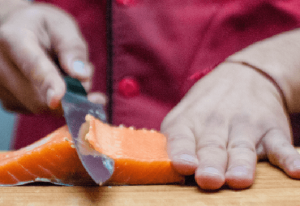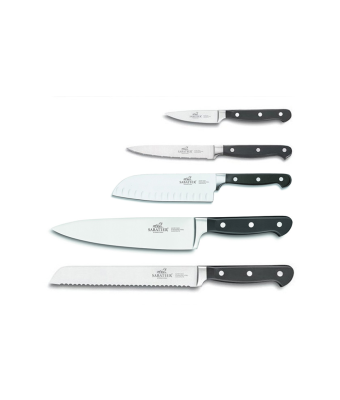Buying Kitchen Knives

Whether you’re a home foodie or a professional chef, the most important part of your kit will likely be your knife. A good knife can make a world of difference in the way you prepare food, helping you to create better dishes.
When it comes to buying knives yourself, there are a few things you should know, so we thought we would put together this everyday guide to help you buy the right kitchen knives for you.
In this guide:
- The Intro
- Know Your Knives
- The Home Kitchen
- The Pro Kitchen
- Common Knife Materials
Know Your Knives…
Paring Knife
This knife has one of the shortest blades of the standard kitchen knives set, making it ideal for more intricate jobs such as peeling and slicing.
Chef’s Knife
This is probably the most used knife in the kitchen and comes in handy for a huge variety of jobs. The blade should round off towards the tip so you can easily use a rocking motion with the knife. Use this knife for chopping and slicing as well as a host of other jobs.
Bread Knife
With a long serrated blade, this knife is perfectly designed to easily cut through bread without tearing or squashing the bread itself. You can also use this knife to slice through cakes or even to carve meat if you find yourself without a carving knife.
Carving Knife
These knives can be up to 14 inches long and are used for carving meat. They are perfectly designed to easily cut thin slices of meat, tending to be a little slimmer than other blades so you can get the perfect cut.
Boning Knife
Designed to be able to do the intricate work of de-boning meat and fish, this knife is usually particularly thin and flexible with a very sharp tip.
Utility Knife
As the name suggests, this knife is all about utility, being practical for a number of different things, from slicing meat to chopping fruit.
Filleting Knife
The fillet knife, like the boning knife is flexible and thin, but is designed to tackle the job of skinning and filleting fish. The flexibility of the blade allows it to easily work through the fish easily and is usually held on its side.
Cleaver
The cleaver is an instantly recognisable knife with a thick, flat blade which is used to butcher meat. The weight of the blade allows you to work through meat and bone, using the sharp tip to cut into the meat.
Santoku Knife
This knife is Japanese in origin and has a distinctive shape with sheepsfoot blade, meaning that the bottom has a straight edge with the dull back of the knife curving to the sharp tip. The blade often has grooves or simples which help to prevent food from sticking to it. Use this knife for slicing, dicing and mincing.
The Home Kitchen
If you are just starting to build your knife set, there are some that will prove more useful for everyday tasks than others, so try starting your collection with these:
- Paring Knife
- Chef’s Knife
- Bread Knife
- Carving Knife
These knives will take care of tasks such as chopping vegetables, carving meat, slicing bread and everything that you are likely to need to do in a home kitchen. Of course, if you are a little more adventurous in the kitchen, you may have use for other knives such as the boning knife and filleting knife.
The Professional Kitchen
If you are running a professional kitchen, you are much more likely to have use for a wider range of knives. You may need to include knives such as a cleaver and a filleting knife which may not be of much use in a home kitchen.
Common Knife Materials
Kitchen knives can be made from a variety of materials, differing in quality and strength. The most common of these materials are:
Stainless Steel
This is a rather cheap metal that will make very affordable knives. However, the blades will need plenty of care as they will dull fairly quickly.
Carbon Steel
With a higher carbon content than regular stainless steel, these blades are harder wearing. The carbon in the metal means that the blades will be able to keep their sharp edge better than stainless steel knives.
Damascus Steel
Blades made from Damascus steel are particularly stylish with distinctive patterns that occur naturally from the forging process. This process involves creating a carbon steel core which is then surrounded by a build up of layers of soft and hard stainless steel. This creates an incredibly durable blade which can hold an extremely sharp edge.
Ceramic
Ceramic blades are known for being particularly hard, holding their sharp edge for far longer than most metal knives. In fact these knives are so hard that they can only be sharpened by diamond sharpeners.
Titanium
These knives tend to combine titanium with other materials such as ceramic, silver or even diamond. This creates a remarkably tough blade which, like the ceramic blade, is also lightweight.
Choosing the perfect kitchen knife or set of knives can be very much down to personal preference, so the decision may require plenty of thought. At Kitchen Knives, we’re always happy to help you choose the best kitchen knives whether you are a home cook or a professional chef. Don’t hesitate to get in touch with a member of our team if you have any questions.

